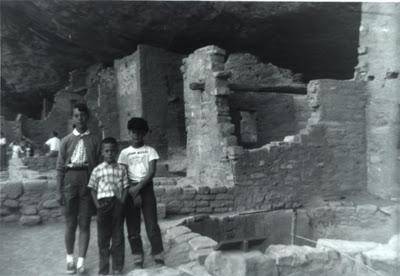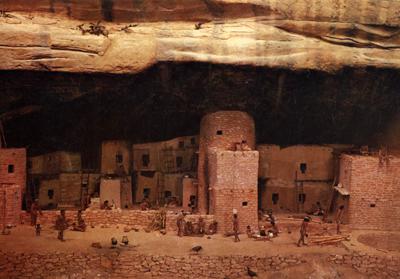
Caroline and her brothers at Spruce Tree House, Mesa Verde, 1958
When I was fourteen years old, my family went on an extended summer camping trip from our home in Minnesota to southern California. One of the highlights along the way was a visit to Mesa Verde National Park in southwestern Colorado. At that time, the campground was on top of the mesa, just a stone’s throw away from the visitor center and the ruins of Spruce Tree House. My brothers and I spent hours climbing the ladders and exploring the ruins. Inside the visitor center I loved peering at the dioramas with their tiny houses and people, and reading about the pottery, tools, and other items in the exhibit cases, trying to imagine what life was like when the Ancestral Puebloans had inhabited these mesas and canyons. In the evening, our family cooked our meal and ate it around the campfire, much as the Ancestral Puebloans must have done more than a thousand years ago.Native Americans known as the Ancestral Puebloans [formerly called the Anasazi] lived at Mesa Verde between A.D. 550 and 1300. They left at a time when there was a long drought and never returned. Their descendants are among the Native American people who live in the southwest today.

Diorama of Spruce Tree House, which was inhabited 1100 - 1300 A.D. The dioramas at Mesa Verde were constructed in the 1930's by the Civilian Conservation Corps.
When I returned to Mesa Verde in 1990 with Richard Hewett to do the research and photography for our book, The Ancient Cliff Dwellers of Mesa Verde, I found the park just as fascinating as I had as a child. The campground had been converted to a picnic area and as we ate our lunches there it brought back memories of my childhood visit. Since then, many more ancient sites within the park had been discovered and excavated, and new research was offering new evidence to explain why the Ancestral Puebloans had abandoned their cliffside dwellings so suddenly.
One of my favorite parts of the park was a small garden plot near the visitor center where the park rangers were growing corn, squash, and beans, just as the Ancestral Puebloans had in prehistoric times. I have always been fond of bean soup and I was delighted to discover in one of the gift shops a package of red beans with a recipe on the back for Anasazi bean soup. The recipe is below. Although I doubt that the Ancestral Puebloans used ham hocks or lemon in their recipes, I can imagine that they might have put a chunk of deer meat and locally gathered flavorings into their beans as they cooked them over the fire. In any case, as you eat this delicious soup, you can imagine that you are high on a Colorado mesa, gazing across the plain below.
Anasazi Bean Soup
1 package of red, pinto type, beans
2 quarts of water
1-2 ham hocks
Salt and pepper to taste
1 16 ounce can of tomatoes
1 large onion, chopped
1 clove garlic, minced
1-1 ½ teaspoons chili powder
Juice of ½ lemon
Soak beans overnight. Drain beans. Add water, ham, salt and pepper. Cook until beans are tender. Add tomatoes, onion, garlic and chili powder and cook another half hour. Add lemon juice before serving. Enjoy!
The high elevation of Mesa Verde, which is about seven thousand feet above sea level, makes it slightly cooler in summer and wetter than the plain below. Both the climate and rich soil made it a good place to grow crops. Beans were added to the Anasazi diet during the period about A.D. 550-750, and were an important source of protein. Anasazi beans were very much like today’s pinto beans. The Anasazi ate them fresh and also dried them to be used later. [Page 25, The Ancient Cliff Dwellers of Mesa Verde by Caroline Arnold (Clarion Books, 1992)] Note: the term Ancestral Puebloan replaced Anasazi after my book was published.
Visit Mesa Verde: The National Park Service website for Mesa Verde has everything you need to know to plan a visit to the park including directions, maps, things to do, and links to information about camping and lodging. There are also pages with downloadable activities for kids and for teachers.
